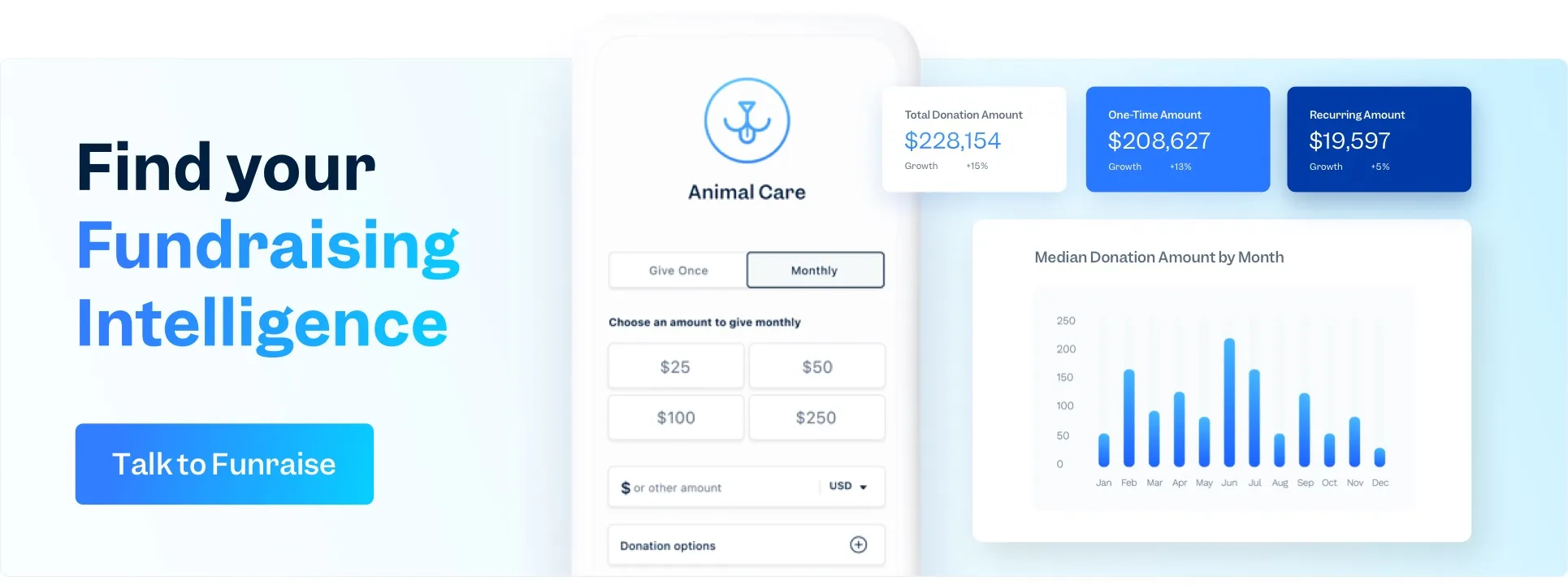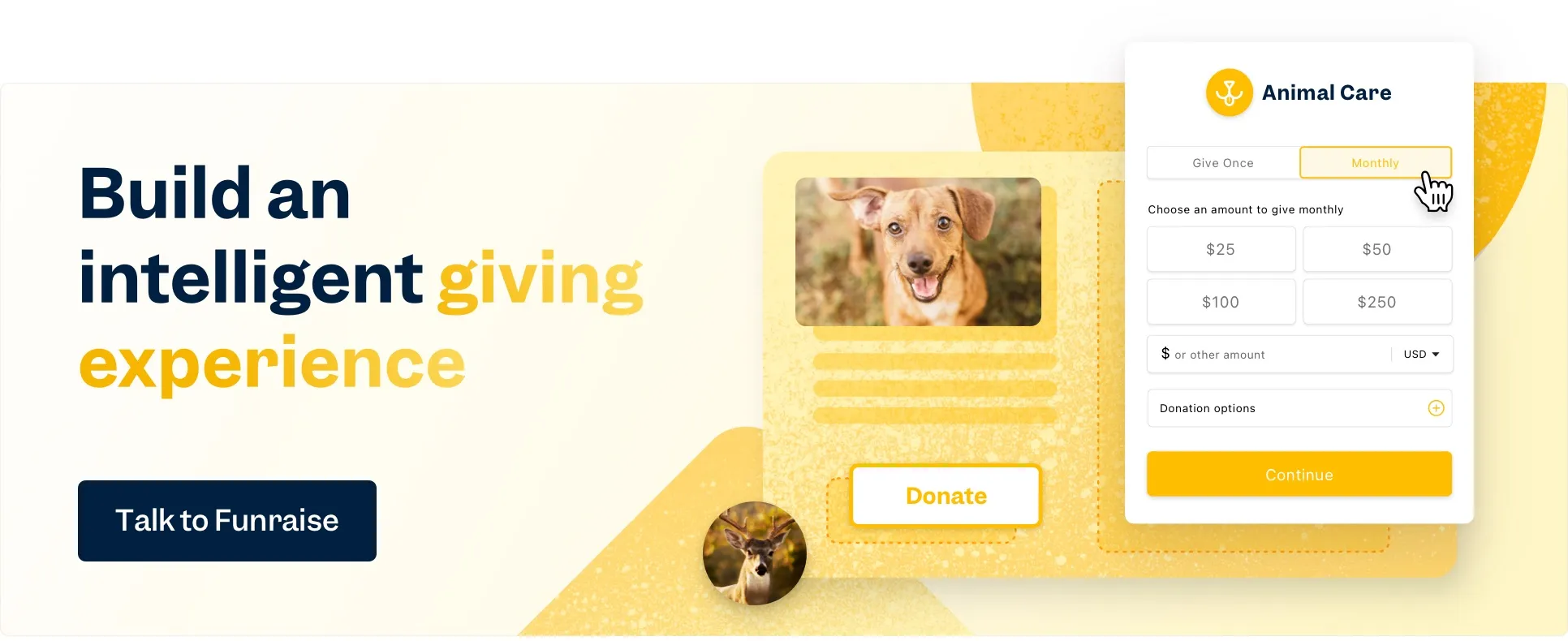If we’ve learned anything from the past few years, it’s that nothing is rock-solid (except dogs, who are always there for us and make every day better, period). In an instant, the best-laid plans of mice and nonprofits can be undone, whether it’s your board president moving to Fiji, a global pandemic, or your funding drying up with the stroke of a pen. The best way to insulate yourself from all that external volatility and uncertainty? Diversifying your types of revenue streams so that no one source of funding is the end all and be all.
First and foremost, though, let's contextualize the collective "diversifyyyyyyy" advice that consultants, business people, and all of LinkedIn exhaled as the executive orders halting foreign aid and (potentially) federal funding were signed into effect in January 2025.
As we write this, things are still up in the air. We're just a few days into a 90-day foreign aid freeze, and millions of people around the world have been put on notice that their life-saving treatment, food, and services received will no longer be rendered. We don't know yet how this will impact U.S. employment either, given how large the nonprofit workforce is.
So... nonprofits are facing an existential crisis, and we're telling you to pivot to a peer-to-peer campaign?
Yeah, we see it. And you're right.
And yet, our thoughts and prayers and good vibes only go so far in keeping nonprofit organizations afloat. As we work the problem together, let us lay out our best insights, strategies, and tools; no matter what today looks like, we have to keep the future in mind.
As we all know, while the best time to plant a tree is 10 years ago, the next best time is right now.
Diversifying your nonprofit's funding in 2025
To start, we'll take a look at what some leaders in the space are saying, see how funding is already being affected, and then lead into how you can do it.
Resources and Responses to Executive Orders in 2025 Affecting Charitable Organizations
Response: On February 7, 2025, National Council of Nonprofits President and CEO Diane Yentel released the following statement in response to a White House memo directing the review of all funding that agencies provide to NGOs for alignment with Trump Administration goals and priorities.
“Today’s White House memo is the latest in a troubling series of attacks on nonprofit organizations working, in the United States and around the world, to provide food, shelter, and housing, eradicate disease, combat human trafficking, provide healthcare and early education, and much more.
Let's be clear: the security, prosperity, and safety of the American people that the Memorandum expresses concern about are enhanced by the work of nonprofits and NGOs. Removing this vital funding or dismantling these organizations will not just diminish the United States here at home and around the world, it will cost lives. The work that nonprofit organizations do day in and day out to meet their lofty missions touch all of our lives, in each of our communities, and are truly what makes America great in the eyes of the world and at home.”
Resource: The National Council of Nonprofits is maintaining a chart of the most pertinent executive orders along with their expected impacts.
Response: Olga Wall, foreign aid contracts and grants expert, and CEO and Founder of Avallon Consulting, suggests doing an internal continuity planning study. Rather than planning to shut down, this allows you to strategize with clear eyes.
While it may be tempting to throw your hands up and assume recovery is impossible, a more prudent approach is continuity planning. This means assessing your existing accrued liabilities as if your grant or contract were terminated tomorrow. ... This is not just good governance; it’s critical risk management, especially when it comes to local obligations made to contractors, grantees, and other partners. You remain solely responsible for these liabilities, and failure to address them could result in adverse local actions that may carry legal, safety or reputational consequences. ...Proactive planning now can make all the difference later.
Resource: Humentum has developed a guidance document, "Navigating the USG Funding Pause for Foreign Assistance Programs", with expertise and input from Olga Wall to support organizations navigating uncertain funding in early 2025.
Response: Jake Wood, CEO of Groundswell and Executive Chairman of Team Rubicon, wrote about the difference in soft power and hard power, and how ex-Secretary of Defense General Mattis viewed defunding the State Department.
While serving as Secretary of Defense, General Mattis once said "if you don't fund the State Department fully, then I'm going to need to buy more ammunition." This was an acknowledgment of the important balance of soft and hard power.
Resource: Everyone's favorite nonprofit community consultant, Julia Campbell, jumped into action, coordinating a LinkedIn Live with Bethany Snyder, former Senate staffer and nonprofit advocacy expert. Lucky you, you can watch it and take action all at once—multitasking! Pro tip: grab all the links from the comments.
Response: Justin Wheeler, CEO and Co-founder of Funraise, is speaking out to our industry, nonprofit supporters, and those ushering in these abrupt changes.
"The U.S. is by far the biggest contributor to global humanitarian aid, supplying an estimated $13.9 billion in 2024, accounting for 42% of all aid tracked by the United Nations. [Reuters] And 9.9% of the US workforce is employed by a nonprofit. ...this impacts our industry in a big way and brings a ton of uncertainty to those reliant on government grants."
As we are just days into the foreign aid freeze, here are some real examples of the challenges the nonprofit community is facing:
- Clinics at camps in Thailand providing shelter for about 100,000 refugees from Myanmar were ordered to shut down after the U.S. froze government funding to the International Rescue Committee, according to a senior aid worker.
- Asia Russell, ED of Health GAP, said the stop-work order “will snatch HIV medicines, prevention services and support from the hands of adults, babies and young people across PEPFAR-supported countries.” [Politico]
- “Without these resources, 6,000 newly arrived refugees [to the United States] we are currently serving may face the prospect of eviction and food insecurity at a time of critical need,” said Krish O’Mara Vignarajah, president and CEO of Global Refuge, an aid organization.
- This is catastrophic," said Atul Gawande "Donated drug supplies keeping 20 million people living with HIV alive. That stops today. The cuts will affect organizations working with 6.5 million orphans and vulnerable children with HIV in 23 countries," Gawande said.
- Gumisayi Bonzo, director of a health nonprofit, has been taking HIV treatment for 23 years thanks to PEPFAR support that made medication affordable. “I have been religiously taking medicines for over two decades, I am living a normal life again, and suddenly we have to stop,” she said. “That’s a death sentence for many people.” [Associated Press]
Resource: See below. Talk to us. Funraise is fighting for you, nonprofit friends 💔💙
Why should nonprofits diversify their revenue streams?
To be sure, revenue diversification requires a lot of planning and a lot of work. So, why should you put in the effort? Being reliant on a single revenue source is akin to putting all your eggs in one basket. If the basket breaks, you’re eating Special K for the next week, and no one wants that when they could be having Ina Garten’s slow-scrambled eggs. By mixing up your nonprofit revenue streams, you know that you always have other options. Then, when a big grant opportunity doesn’t come through or a major gift donor says ciao, you can avoid a panic attack, knowing that they’re not the only fish in the sea. Huh, we’re really breaking out the adages and idioms today, aren’t we?
Put it another way, Todd Hiestand, Co-owner of Liminal, a creative branding agency for nonprofits, talked about diversified fundraising revenue streams on the Nonstop Nonprofit podcast.
"...at some point you hit a max if all you're doing is individual donor dollars... but there's also conversations around where are the revenue streams coming from? So the question is, how are we going to start building a roadmap to get to impact?"
Benefits of diversifying your revenue
In addition to protecting your nonprofit from the ups, downs, and uncertainties of our rapidly changing world, diversifying your fundraising initiatives has many benefits for your organization.
- Reduce financial risks. First and foremost, relying on a primary source of revenue represents a major financial risk. You never want to rely 100% on any one anything—that’s why our hobbies include collecting rare stamps AND crocheting miniature animals. By mixing it up, you ensure there’s always something else to fill the void.
- Grow your network. Having multiple revenue streams is like networking for your finances. Branching out is a great way to meet new people and drive visibility for your organization. And when you meet people and make connections, you keep finding new opportunities to grow.
- Build long-term resilience. A mix of nonprofit funding sources protect your organization from outside shockwaves. For nonprofits relying on in-person events as their best funding channel, COVID was a disaster. For those with other regular revenue streams, it was still a disaster—but a more manageable one.
- Increase your earning potential. This isn’t a sure-fire thing, but it’s a definite possibility. With more fundraising strategies, you open your organization up to increased growth. If you accept stock gifts, maybe the market will go up; if you sell e-merch, maybe your branded tank tops will go viral. You never know!
- Impress external funders. During that seemingly interminable waiting period when grant providers are evaluating your application, they’re also considering your long-term organizational health. After all, they don’t want to give the big bucks to a nonprofit that’s in danger of shuttering any day. One way they confirm your stability is by checking your current funding sources to ensure you’re not overly reliant on any one revenue source. So, make ‘em proud!
- Built-in predictability and stability. Like the resilience and risk-reduction bullet points above, this speaks to your nonprofit’s future plans by building a solid core today. When you have strong, proven, diversified funding streams, your Big Ideas can focus on the difference you’re making, not how best to compete for a new audience.
- Answer to yourself. If you get a lot of money from restricted funds or private foundation grants, the people giving that money have a big say in your spending. The less reliant you are on a single source of revenue, the more you can spend your funds as you see fit while furthering your mission.
10 ways to diversify your nonprofit revenue streams
At this point, you’re just like, “I get it, I get it, now what are my options?” We’re so glad you asked, because there’s truly something to suit every palate.
1. Lean into stocks
In an increasingly cash-free society, nonprofits only accepting cash or credit donations from individuals are severely limiting their potential revenue streams. If you’re looking for a good place to start, lean into stocks. A 2016 study found that nonprofits receiving only cash gifts grew an average of 11% over a five-year period while those receiving non-cash gifts in the form of securities grew 66% (Professor Russel James III). That’s quite a difference!
2. Do prospect research.
The wealth gap is, unfortunately, widening, making those major donors even more important than before. If you have just a few folks in your leadership circle, you’ll want to expand, but finding potential donors requires some online sleuthing. Your development team will want to look into wealth and philanthropic indicators to find folks who have a bit more to give.
3. Go global.
Many of us receive fundraising email marketing from the same 20 charities every single month. And that makes sense because it can feel like there are only so many interested donors, and if not them, then who? If you feel like your prospective donor base has dried up, try expanding your outreach to other states and even other countries. To get you started, we’ve put together this handy guide to building a global donor network.
4. Think peer-to-peer.
One of the best ways to diversify is to embrace lots of smaller individual donations rather than being overly reliant on narrow major gift fundraising. You cultivate community with your dedicated supporters while growing your network to include everyone they know. Then, with thousands of loyal donors engaged in peer fundraising campaigns, you won’t break a sweat if a few stop giving.
5. Plug into corporate giving.
Nowadays, corporations are being called on to do more than create value for shareholders, and that’s good news for nonprofits. You can capitalize on recent corporate responsibility trends by including matching-gift opportunities on your donation form and ensuring everyone is aware of the opportunity. Furthermore, reach out to businesses about various corporate sponsorship opportunities.
6. Make some passive income.
Amazon Smile is gone, and whether you loved it or secretly hated it (it was kind of a pain for a lot of folks, TBH), it was a nice way to make a little extra each month without a ton of effort. But now, you can sit down and strategically implement some new passive income sources of revenue that are sure to be way better. We’ll get you started with some ideas for how to rake in that passive income.
7. Apply for grant funding.
Yes, they’re a lot of work, but if you’ve done some groundwork, you can streamline the grant application process, and it’ll really pay off. To up your odds of grant funding success, consider hiring a full-time grant writer. They’re magic!
8. Try a subscription model.
Recurring giving through monthly subscriptions is a more reliable source of revenue than annual gifts. Lean into your recurring giving options by highlighting them across social media and including recurring upgrade features on your donation forms.
9. Mix up your events.
We assume you’re already doing some form of fundraising events. Maybe you do a gala every December, or maybe you’re all in on webinars. Whatever you’re doing, mix it up. If you’re all online, try in person. If you’re doing dinners, try a brunch. The broader your net, the more butterflies you’ll catch! (And then release, very gently, and also donate to a Monarch conservation program.)
10. Let your current donors into the inner circle.
It’s a pretty common and effective strategy these days: donors cover the fees. Turn your online donation form into an opportunity for potential donors to spring for a little extra so that your transaction and processing fees are covered.
Tips to earn more money with diversified revenue streams
Now that you have a plethora of varied funding ideas at your disposal, you can wrangle your team members and get diversifying. And if you’re still feeling a bit stymied, we have a few tricks to get you on your way.
- Visualize your revenue streams. Wondering whether you even need to diversify your funding opportunities in the first place? Try visualizing it. Collect all your data in Excel, calculate what percentage of your current funding each income stream makes up, and then make a pie chart. If you only have one or two slices, or any one slice is more than a quarter of your total revenue, you’ll want to take a step back and reevaluate.
- Really do some planning. Overall, pursuing additional revenue streams is good for your org’s long-term sustainability and revenue. But it takes money, and it’s complex, and it can even lead to mission drift. So, work it into your budget, make sure you have the time and personnel, and make a plan to stay laser-focused on your mission.
- Think across demographics. If you’re overly focused on Boomer donations, you’re not alone. But they’re getting older, so diversifying your donor demographics now is another way to weather trying times. If you’re already building relationships with supporters of all ages, you’ll never have to scramble to create a groovy TikTok account with zero knowledge of TikTok. (We’re pretty sure “groovy” is making a comeback.)
- Get creative. We keep talking about “diversified fundraising revenue streams” but put another way, we’re just saying to get creative with your fundraising efforts. Try that new idea. Host that out-there event. Put on a disguise and rub elbows with the .01% at a password-protected black-tie gala, then convince everyone there to give away half their wealth. You can do it!
- Partner with other organizations. You can partner with local businesses and fellow nonprofits to offer complementary services and reach a broader audience. You can also share each other’s posts on social media, give a shout-out in your newsletter, or host a joint event. It’s the perfect way to build community and a safety net.
It’s a wild world out there, but that doesn’t mean you can’t plan for it. By diversifying your revenue streams, you’ll be prepared for what lies ahead, be it zombie apocalypse or robot takeover. Now go forth and diversify!
Diversifying revenue streams: Key takeaways
- If your nonprofit is dependent on just one or two revenue streams, you’re setting yourself up for financial risk in an uncertain environment.
- By diversifying your revenue streams, you can increase your organization’s long-term sustainability, grow your network, and impress external stakeholders.
- Be proactive and make diversified funding sources a part of your organization’s strategy, allotting resources and personnel to make it a reality and then monitoring the outcomes carefully.































.webp)
.webp)











.webp)
.webp)

.webp)
.webp)
.webp)




